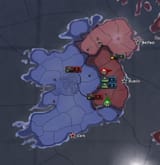Search Results
6/18/2025, 5:23:14 PM
Ireland Rises
May 17, 1933
If the Grand Tory Coalition was the first casualty of the Automation Crisis, the second was the Ireland revolt. After years of attempts at Home Rule, Ireland finally received a limited form of autonomous governance on January 10, 1916. This came about from riots over bread shortages and the Dublin Uprising earlier in 1915. Since 1916, Ireland finally has seen relative peace, though the Irish resistance members denounced the autonomous state and vowed to continue fighting. It would seem that day has come.
Led by Michael Collins, Irish across the island revolted. They had apparently hoarded small arms for years, enough to fully arm four divisions worth of infantry. They were more experienced than your average militia, too, having practiced firing formations and shooting exercises on weekends in isolated rural areas. They also had numerous improved explosives, which they placed on roads outside major and other strategic locations. The population was on their side this time. They had home advantage.
Even worse, Imperial Britain's intervention forces were in the Middle East when the fighting broke out. The timing was too coincidental. There had to be a spy on the inside informing the Irish resistance of British troop movements. Having arrived in Palestine, thousands of British soldiers now are being placed back on transport convoys and shipped to the Irish front.
Maybe Ireland could have arranged some sort of additional autonomy if the socialists had won the election, but with the National People's Party in power, nobody expected Britain to offer the carrot to resolve this conflict. Iron and fire would carry the day. And no small Irish rebellion has the chance to defeat the Empire.
May 17, 1933
If the Grand Tory Coalition was the first casualty of the Automation Crisis, the second was the Ireland revolt. After years of attempts at Home Rule, Ireland finally received a limited form of autonomous governance on January 10, 1916. This came about from riots over bread shortages and the Dublin Uprising earlier in 1915. Since 1916, Ireland finally has seen relative peace, though the Irish resistance members denounced the autonomous state and vowed to continue fighting. It would seem that day has come.
Led by Michael Collins, Irish across the island revolted. They had apparently hoarded small arms for years, enough to fully arm four divisions worth of infantry. They were more experienced than your average militia, too, having practiced firing formations and shooting exercises on weekends in isolated rural areas. They also had numerous improved explosives, which they placed on roads outside major and other strategic locations. The population was on their side this time. They had home advantage.
Even worse, Imperial Britain's intervention forces were in the Middle East when the fighting broke out. The timing was too coincidental. There had to be a spy on the inside informing the Irish resistance of British troop movements. Having arrived in Palestine, thousands of British soldiers now are being placed back on transport convoys and shipped to the Irish front.
Maybe Ireland could have arranged some sort of additional autonomy if the socialists had won the election, but with the National People's Party in power, nobody expected Britain to offer the carrot to resolve this conflict. Iron and fire would carry the day. And no small Irish rebellion has the chance to defeat the Empire.
Page 1
